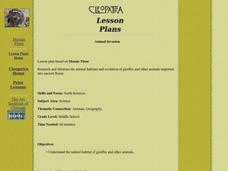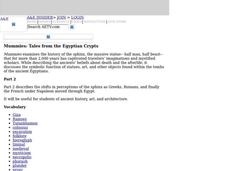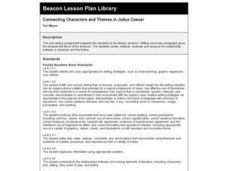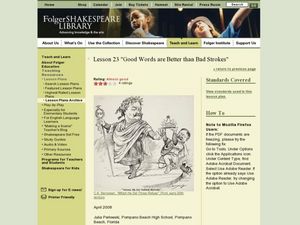Curated OER
Shakespeare Limericks 2
These fun limericks all point to a Shakespeare play. You fill in the blank with the title of the play each limerick points to. A creative way to get your readers thinking!
Curated OER
Reasons for Settling the New World
After studying the reasons settlers entered the New World, primary learners try to persuade others to enter this new land. Class members present their arguments in a variety of ways including posters, writings, and charts. Richly...
Curated OER
Using Words as a Way into Rick Riordan's The Lightning Thief
Use the Visual Thesaurus to predict the subject matter of Rick Riordan's book The Lightning Thief. A pre-reading activity encourages middle schoolers to use context clues and word meaning to discover what the book is about. After...
National Endowment for the Humanities
Galileo: Revealing the Universe
To gain an understanding of the significance of Galileo Galilei's revolutionary ideas, class members watch the short video "Stargazing Before Galileo," and conduct a close reading of Galileo's Sidereal Messsenger. They then...
Time Warp Trio
See You Later, Gladiator!
Young historians take a look at the age of gladiators, and the cultural atmosphere present when they staged their epic battles. Pupils pretend to be reporters and write newspaper articles about one of the events they stage. Then,...
Museum of Tolerance
The Role of Citizens in a Participatory Democracy
Groups research participatory democracies and compare the role and rights of citizens in ancient history with those in recent U.S. history. Guided by a series of questions, individuals compose a persuasive essay in which they discuss the...
Curated OER
Animals in Myths and Real Life
Learners research the role of lions, elephants, and bears in ancient Roman life and mythology. They develop a strong understanding of the role animals played in important ancient Roman historical events and myths.
Curated OER
The Alphabet is Historic
Students describe how the Phoenicians, Greeks and Romans passed down the alphabet through the generations. They compare and contrast the letters from early alphabets to the one of today and discuss how they are different. Using a map,...
Curated OER
Italian Renaissance
Fifth graders explore the Italian Rensissance in this six lessons unit. The prominent citizens, the ideas, values, art, philosophy, and literature of the are seen as a rediscovery of Ancient Greek and Roman times.
Curated OER
Wild Kingdom
Young scholars research and discuss the natural habitats and various evolutionary theories of giraffes and other animals imported into ancient Rome.
Curated OER
Introduction to the Byzantine Empire
Students research the founding of the Byzantine Empire in this lesson. They examine the geographic advantages of Constantinople, and the establishment of the empire. Finally, they compare the Byzantines, Romans, and present-day...
Curated OER
Animal Invasion
Students research and illustrate the natural habitats and evolution of giraffes and other animals imported into ancient Rome. They draw a map of Europe, North Africa, and West Asia and draw the animals from each region in their proper...
Curated OER
Mummies: Tales from the Egyptian Crypts Part II
Learners explore the shifts in perceptions of the sphinx as Greeks, Romans, and finally the French under Napoleon moved through Egypt.
Curated OER
Mythopoly: Where in the World Is Odysseus?
Students study Greek mythology. Among other activities, they evaluate a work of art and discuss the influence, significance, and history as it pertains to mythology. As a culminating activity they create a board game that shows their...
Curated OER
The Tragedy of Julius Caesar
In this world history instructional activity, students find the words in the puzzle related to the ruler Julius Caesar and the answers are found at the bottom of the page.
Smithsonian Institution
Dia de los Muertos: Celebrating and Remembering
Help scholars understand the history, geography, traditions, and art of Dia de los Muertos, the Day of the Dead. Find background information for your reference as well as a detailed cross-curricular lesson plan. Learners compare...
Curated OER
Connecting Characters and Themes in Julius Caesar
Fourth graders prepare for the literary analysis. They locate, interpret, evaluate and analyze the relationship between a character and the theme. After a lecture/demo, 4th graders write topic and detail sentences, then correctly put...
Curated OER
The Adder and the Ladder: Figurative Language as Persuasion in "Julius Caesar"
Young scholars read and analyze figurative language used in William Shakespeare's "Julius Caesar." They participate in a choral reading of a soliloquy, analyze the soliloquy for figurative language in small groups, and discuss how the...
Curated OER
Vox Populi: Brutus's Speech and the Response of the Plebeians
Tenth graders explore two rhetorical strategies (ethos and audience appeals) to analyze their effects in Brutus's speech in 3.2. They are given the opportunity to participate as members of Brutus's audience by assuming the roles of...
Curated OER
Julius Caesar: Act III Reading and Study Guide
In this reading and study guide worksheet, students define 3 vocabulary words, define 4 literary terms, and respond to 21 short answer questions pertaining to Act III of "Julius Caesar" by William Shakespeare.
Curated OER
Julius Caesar: Act V Reading and Study Guide
In this "Julius Caesar" reading and study guide worksheet, students define 2 vocabulary words, define 5 literary terms, and respond to 16 short answer questions pertaining to Act IV of "Julius Caesar" William Shakespeare.
Curated OER
Direct the Ghost of Caesar
young scholars read the Ghost of Caesar scene and use prompt books to stage the scene. In this Shakespeare instructional activity, students read the scene and then stage the scene. Young scholars make prompt books for the staging...
Curated OER
Lesson 22: As constant as the Northern Star: Examining Static and Dynamic Characters in Julius Caesar
Young scholars examine the play Julius Caesar. In this literature analysis instructional activity, students work in groups to identify changes in various characters from the story. They examine various aspects of the...
Curated OER
Good Words are Better than Bad Strokes
Learners research negative campaigns and propaganda and then interpret characters from Julius Caesar in that light. In this negative campaign lesson plan, students take the character and create visual images to depict the characters in a...























